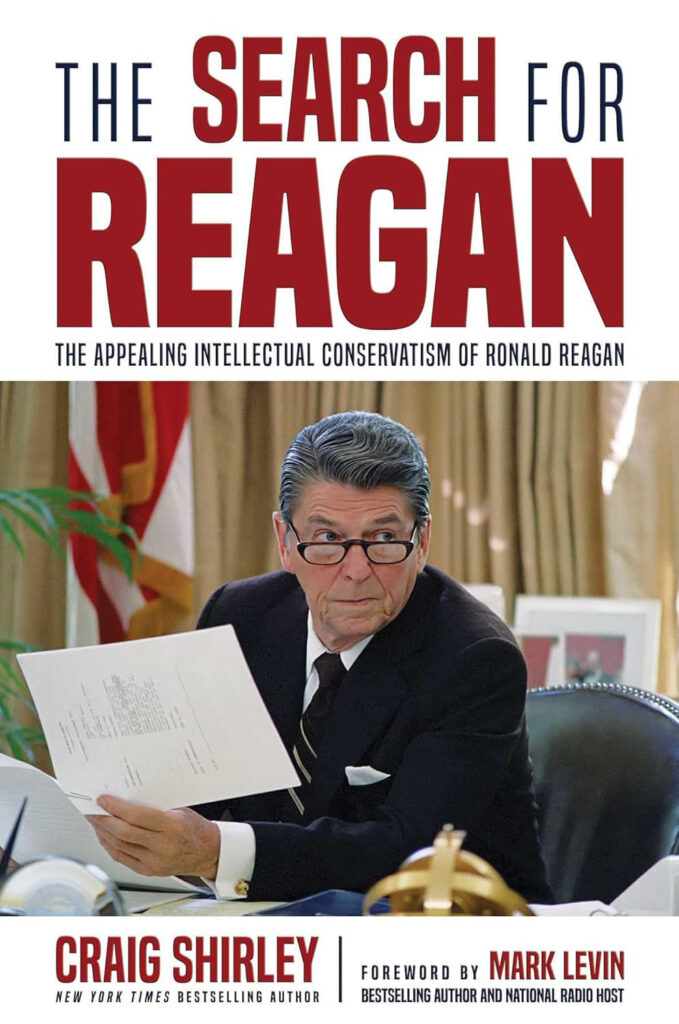ARTICLE AD BOX
The following is an excerpt from presidential historian Craig Shirley’s forthcoming book “The Search for Reagan: The Appealing Intellectual Conservatism of Ronald Reagan,” to be published in February. It recounts the thinking that went into President Reagan’s 1981 selection of Sandra Day O’Connor to be the first woman appointed to the Supreme Court. O’Connor, who served on the court until 2006, died Friday at the age of 93.
During the 1980 campaign, Ronald Reagan was advised to make an appeal for the women’s vote by pledging to appoint the first woman to the Supreme Court if elected.
It seemed like it was one of those campaign throwaway lines that every political operation goes through, but Reagan took this one seriously.
In the 200-year history of the court, there had never been a woman on the bench, but the court did make a lot of landmark decisions without their presence, including Marbury v. Madison, the Dred Scott case, Roe v. Wade, Plessy v. Ferguson, and significant civil rights and personal rights decisions.
Reagan usually eschewed these silly campaign stunts, seeing them as offensive to his intellect, but this one intrigued him. …

This decision was months in the making. According to Reagan campaign aide Stu Spencer, the concept occurred at a meeting with progressive Republican leaders in Massachusetts. They were displeased by Reagan’s opposition to the Equal Rights Amendment, but weren’t willing to write off the Gipper just yet.
GOP Rep. Margaret Heckler asked Reagan if he would consider appointing a woman to America’s highest court, and Reagan “appeared receptive” to the idea. The topic was reintroduced to Reagan in October when Spencer asked him, “Do you have any problem appointing a woman to the Supreme Court?” Reagan replied, “Hell, no. Not if she’s qualified.”
The announcement was immediately met with skepticism and criticism from the press and Democrats. Reporters immediately grilled Reagan on whether or not the candidate would share Reagan’s opposition to abortion and the Equal Rights Amendment. President Jimmy Carter was similarly dismissive, stating, “Equal rights for women involves more than just one job for one woman.” Carter would even go on to assert that it was wrong to reserve court seats “for a particular kind of American.” …
Interestingly enough, when Reagan made his pledge to pick a woman for the Supreme Court, he didn’t say his first choice would be a woman. What he said was “one of my first choices” would be a woman.
Reagan may have been slow to master the art of politicking, but he had learned enough by 1980 to always leave himself a little wiggle room. Thus, should a seat on the court open up, Reagan was under no real obligation to fill it with a woman. While he would undoubtedly be criticized for not doing so, he would not technically be violating his campaign promise.
Yet, to Reagan’s credit, he abhorred this type of political doublespeak, especially when he was forced to use it. He had no intention of reneging on his promise.
Reagan later wrote in his autobiography that within “the first few months” of his administration, he tasked his office to find the most qualified women in the country to choose from. Reagan noted that this search began “long before” a vacancy opened up.
On June 18, 1981, associate Supreme Court Justice Potter Stewart announced he would be retiring from the court the following month. The career lawyer, judge, and legal scholar had served on the court since 1954, when he was appointed by President Dwight D. Eisenhower.
Much to Eisenhower’s ire, Stewart ended up a swing vote judge for much of his tenure. He had voted along with the majority in the court’s landmark 1973 decision on Roe v. Wade. He was largely remembered for an opinion in which he wrote that, when it came to what is and isn’t pornography, “I know it when I see it.” He would later lament the popularity of the quote, fearing its pragmatic implications overshadowed his actual judicial philosophy.
With [Stewart’s] retirement, it now fell to Reagan to select his successor. Reagan ideally wanted a judge with originalist leanings that would be in line with his own. However, he had no illusions that his selection would always vote alongside the president, so this was not his primary concern.
He later wrote:
I knew that judges had a way of going their own way once they were sitting on the bench. Dwight Eisenhower once told me he believed that the biggest mistake he had made as president was appointing Earl Warren as chief justice of the Supreme Court because, in Ike’s view, Warren had changed his stripes and turned into a liberal who took it upon himself to rewrite the Constitution.
I’d had a similar experience with one of my appointments in California. Even though you couldn’t always be certain how the judges you appointed would act once they put on black robes, I intended to do my best to choose the most responsible and politically neutral jurists I could find.
Reagan didn’t want the decision to be politicized in any way.
“The only litmus test I wanted, I said, was the assurance of a judge’s honesty and judicial integrity. … I wanted judges who would interpret the Constitution, not try to rewrite it.”
Like Reagan, Sandra Day (O’Connor later by marriage), came from a hardscrabble background. She was the daughter of the largest and most successful ranch owners in her part of Arizona. Yet the ranch lacked running water or electricity for much of her youth.
As she spent her childhood branding cattle and repairing farm equipment, the courts, much less the Supreme Court, were the farthest thing from her mind. Though a bright young girl, educational opportunities were few and far between where she lived.
All things being equal, she would likely become a successful rancher in her own right. Yet, her parents were insistent she receive a quality education. They sent her to live with relatives who lived closer to better educational prospects.
As a student, O’Connor was a pioneer. At 16 years old, she enrolled at Stanford University as one of only a handful of women to make the cut, then continued at Stanford Law School. At this time, women made up only 2 percent of law school students. She was an editor of the prestigious Stanford Law Review and graduated third in her class.
Less well-known, she also likely set another record by rejecting no less than four marriage proposals while in law school, including one by future Supreme Court Chief Justice William Rehnquist.
Despite these high marks, most offices flatly refused to hire a woman, leaving her relegated to low-paying positions where her skills were deeply underutilized.
Despite these barriers, she persisted, and, in 1979, she was elevated to the Arizona Court of Appeals where her judicial record and strong reputation later caught the attention of Reagan’s team. In total, Reagan’s aides had selected 25 potential nominees, and she had made the final five.
Critically, on the “final five” list created by Reagan’s Deputy White House Chief of Staff Michael K. Deaver, O’Connor was one of only two women. The other three potential nominees were all men.
Mr. Deaver shared this openly with reporters, which was odd. Letting the public know that Reagan was considering male candidates and, ergo, seemingly failing to follow through on his campaign promise could have easily backfired. Yet the exact opposite seemed to occur.
By signaling clearly that Reagan was also considering men, he made it explicitly clear that O’Connor was not selected because she was a woman—she was selected because she was the best.
Thus, on July 8, 1981, President Ronald Reagan announced that he would nominate Sandra Day O’Connor to be the first woman to serve on the United States Supreme Court. In his announcement, he called O’Connor a “person for all seasons, possessing those unique qualities of temperament, fairness, intellectual capacity and devotion to the public good which have characterized the 101 ‘brethren’ who have preceded her.”
The front page of the New York Times ran a large, favorable photo of her above the fold with the headline “A Reputation for Excelling: Sandra Day O’Connor.” The article was largely favorable, noting: “She is said, by friend and foe alike, to be notably bright, extremely hard-working, meticulous, deliberate, cautious and, above all, a Republican conservative.” An unnamed Arizona Democrat legislator noted she wasn’t “your far-out Republican … if you have to have a Republican on the court, well she’s about the best we could hope for, to be perfectly honest.”
How magnanimous of him.
Despite those glowing reviews, another New York Times headline read: “Reagan Nominating Woman, An Arizona Appeals Judge, to Serve on Supreme Court: Reaction is Mixed.”
Surprisingly, it was not Democrats concerned with her judicial record, but fellow conservatives. Her previous openness to a more narrowly focused Equal Rights Amendment as well as her support for “a 1970 bill to legalize abortion and a 1973 bill permitting Arizona state agencies to participate in family planning” meant her confirmation was immediately opposed by the National Right to Life Committee, Moral Majority and other groups opposed to abortion.
Nevertheless, Reagan went out of his way to assuage these concerns. While, in keeping with court tradition, she would not share opinions with the Senate or public that would undermine later court decisions, Reagan said that she had privately assured him that she was nominally against abortions.
In any case, despite opposition from some high-profile conservatives like Jerry Falwell, Reagan pressed forward with her nomination. After confirmation hearings that she would later describe as “unpleasant,” she was swiftly confirmed with a unanimous 99 to 0 Senate vote.
The cynic will point to cold, hard politics as the motivating factor behind President Reagan’s decision—that he wasn’t “winning” women over and needed something simple and performative to lure them into his camp. Similar statements have been made about President Joe Biden’s pledge to nominate the first black woman to the Supreme Court. Yet, when it comes to Reagan at least, it was about far more than math.
Reagan despised dividing America by race, gender, or creed. He preferred to speak to all Americans, yet that preference came at a cost. He knew he needed to show Americans that he was for all Americans. All good leaders must listen to those they lead. They need not always agree with them or do what they say, but people need to be heard.
When he listened in 1980, he heard that women were worried about his policies. They were worried he would lead America into a war, and they were worried he didn’t support women. So, Reagan evolved. When he discussed foreign policy, he tightened his messaging. No more off-the-cuff comments about blockades or troop deployments. He spoke of the great implications and greater evils of the Soviet Union while making it clear at every turn that the only guarantee for a peaceful America was a strong America.
The same held true for women’s rights. Unlike Reagan’s critics, he considered national security and financial prosperity just as much a women’s issue as it was a men’s issue. Yet, when it became clear that more had to be done, he did just that. He openly spoke of the challenges women faced and how his administration would seek to address them.
In 1980, Reagan won 46 percent of women voters. In 1984, he won 57 percent.
At the Sandra Day O’Connor Institute for American Democracy, they invoke the words of O’Connor herself as to why Reagan nominated her and what it meant for the country. In her 2004 Stanford Commencement speech, she said:
His decision was as much a surprise to me as it was to the nation as a whole. But Ronald Reagan knew that his decision wasn’t about Sandra Day O’Connor; it was about women everywhere. It was about a nation that was on its way to bridging a chasm between genders that had divided us for too long.
Have an opinion about this article? To sound off, please email letters@DailySignal.com and we’ll consider publishing your edited remarks in our regular “We Hear You” feature. Remember to include the url or headline of the article plus your name and town and/or state.
The post How Reagan Chose O’Connor for Supreme Court appeared first on The Daily Signal.
.png)
 1 year ago
86
1 year ago
86








 English (US)
English (US)